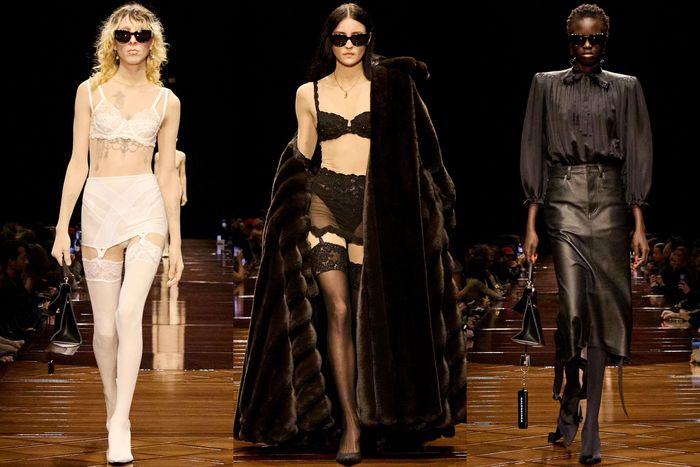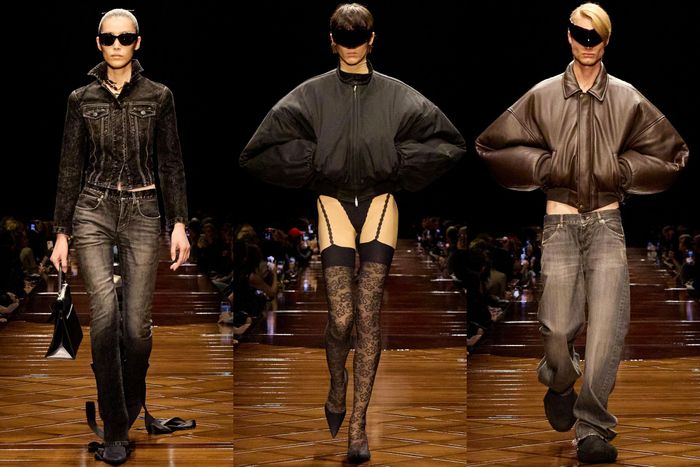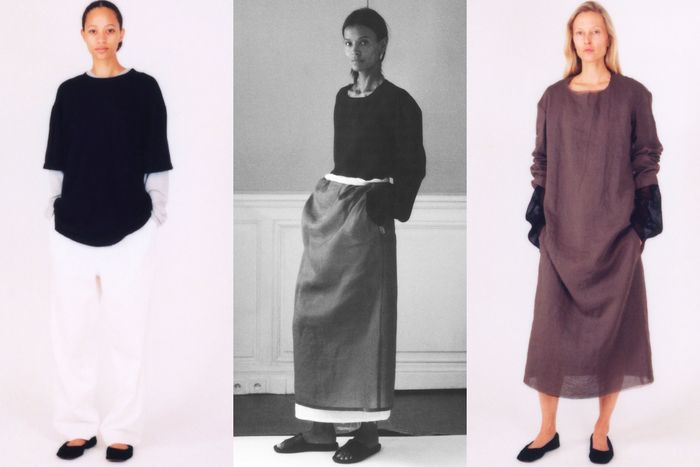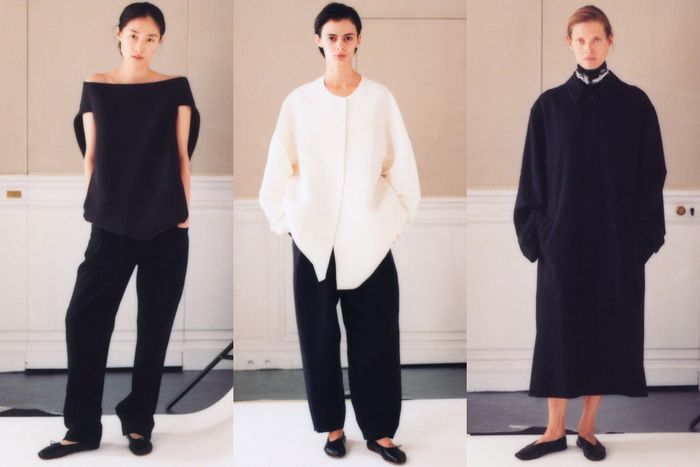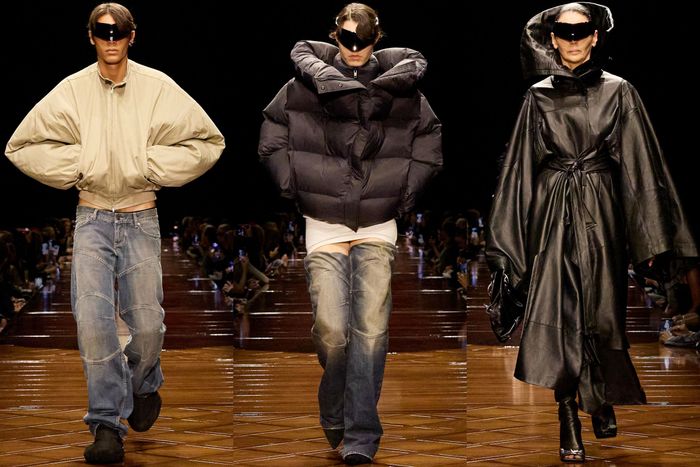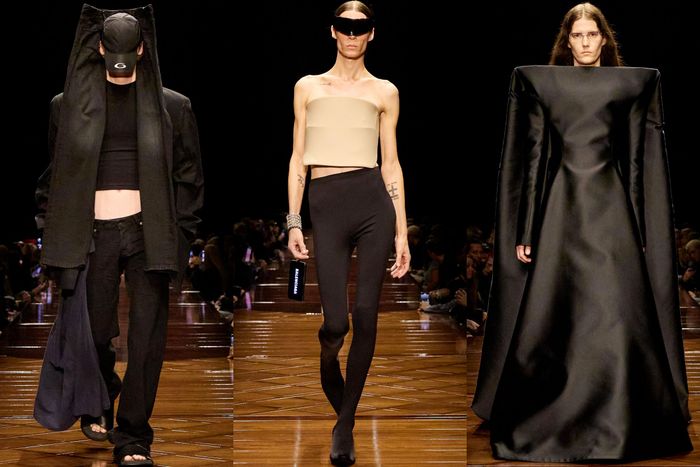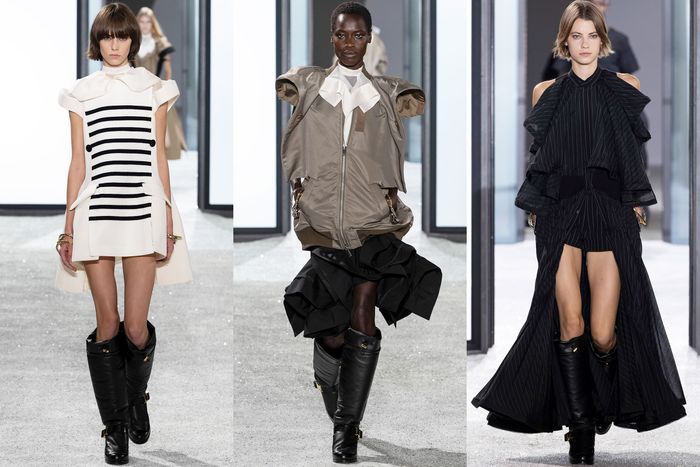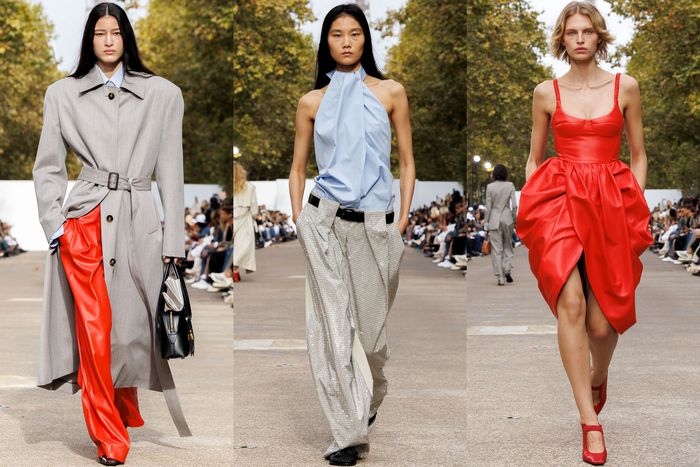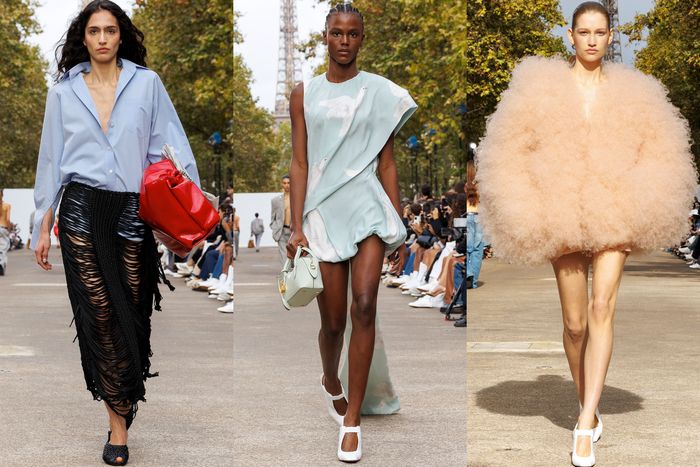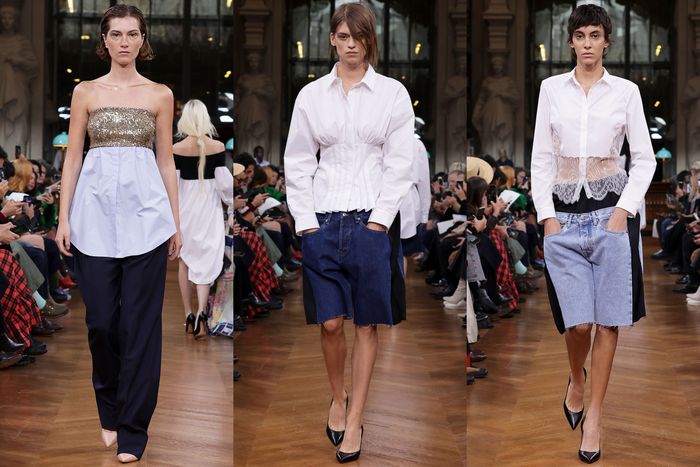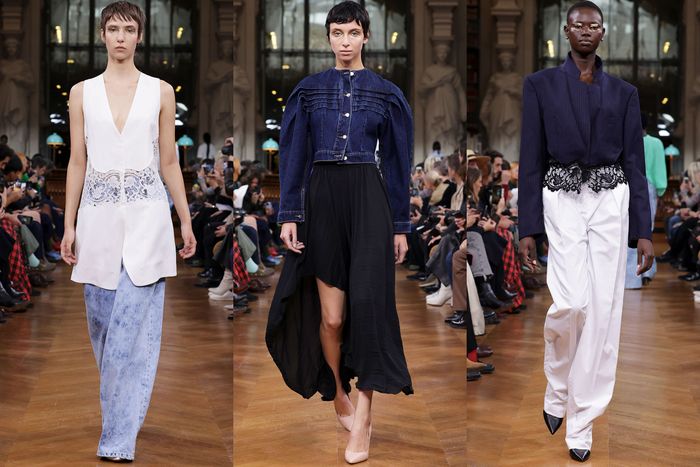Fashion
Balenciaga’s New Sexual Charge
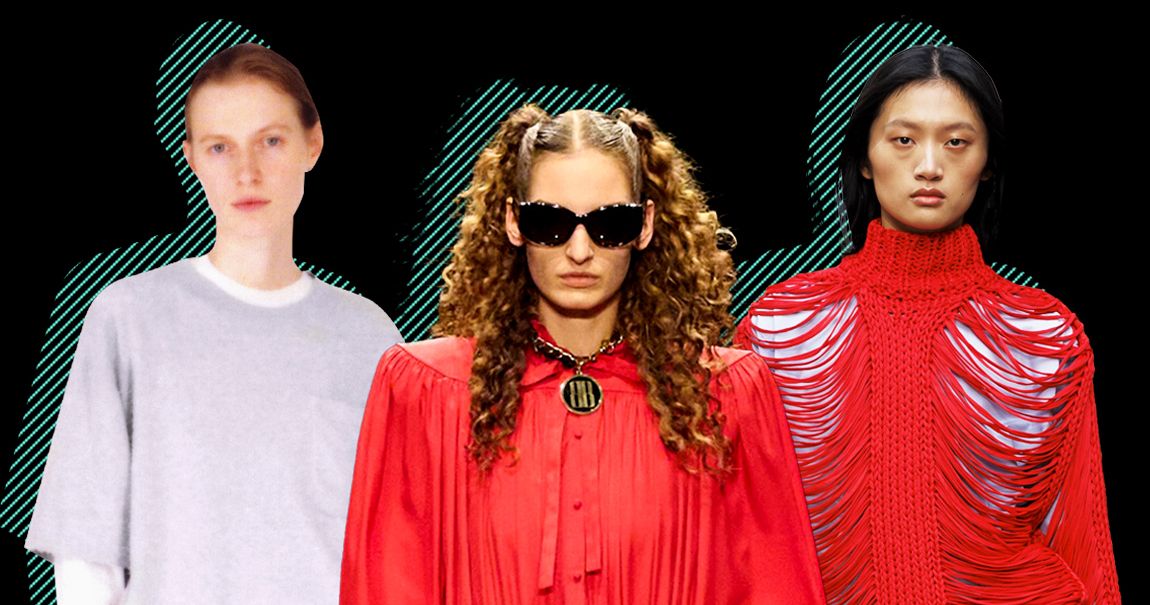
Left to right: The Row, Balenciaga, Stella McCartney.
Photo-Illustration: by The Cut; Photos: Courtesy of The Row, Balenciaga, Stella McCartney
To reach the Balenciaga runway — staged inside an enormous temporary structure in central Paris that resembled a gray dress box — you followed a series of black-carpeted and black-curtained corridors with minimal lighting. You were aware that you were going deeper into the space, but the darkness, combined with anticipation, was disorienting. There was a distinct air of sex club. Giggling, I hurried along another corridor and saw a small sign for my seat section, with an arrow pointing to a short flight of stairs. I went up.
What greeted everyone entering through different doors was a table of mahogany hue and preposterous scale: more than 150 feet long and perhaps a dozen feet wide, with dining chairs along the sides. Those of us seated on the adjacent, black-upholstered risers were looking slightly down on the higher-ranking guests around the table, people like the actors Nicole Kidman and Kyle MacLachlan, the Kering group chairman Francois-Henri Pinault and his wife Salma Hayek, and editors-in-chief. Naturally, the setup was a source of tension. Who gets a seat at the table? An older man was wearing a white terrycloth bathrobe, with quiffs of hair — everyone noticed him.
Balenciaga
Photo: Courtesy of Balenciaga
On the other hand, if you think about it, the dark corridors, the long table, and the strange but familial faces were straight out of Harry Potter.
Demna, the creative director of Balenciaga for nearly a decade, isn’t the first to hold a tabletop show. Martin Margiela and Dries Van Noten each did one. But let’s forget the set and look at the visual messages in the clothing. The most obvious is that the high-fashion business is preposterous, twisted by money and complacent attitudes toward design.
Balenciaga
Photo: Courtesy of Balenciaga
Indeed, this has been a lackluster Paris season, partly because so many major brands are pushing dressy, overtly feminine clothes, like those at Valentino. Or, like Loewe, the designs are often conceptual; they’re innovative in craft and even wearable, but you’re unlikely to see them in stores.
At the other extreme is The Row. Mary-Kate and Ashley Olsen presented their high-end basics — in cottons, cashmere blends, soft wools — in the hushed setting of their offices near the Place Vendôme. Again, the Olsens asked guests not to take photos during the show. Instead, we were given pretty Japanese notebooks and pencils and told pictures would be available several days later. Alas, the photos they sent out (on Monday) only served to underscore how ordinary — that is, without real design merit — this collection was. Their previous show had far more oomph. In terms of luxurious simplicity, the Olsens have taken a page from both Zoran and Margiela. Still, there was not a distinguishing element of design here. If a model had walked out in The Row show wearing her own layered gray T-shirt and white painter’s pants, would we have known the difference?
The Row
Photo: Courtesy of The Row
The Row
Photo: Courtesy of The Row
What Demna did so effectively was to break our assumptions about the familiar and the startlingly new and different. At the same time, he set his ideas in a context that could be read as political — specifically, that designers are human beings. As he said, “We’re not robots who can produce amazing products every single day. But give me maybe two weeks to focus on an idea, and maybe I will have it.”
The soundtrack conveyed that tension. Arranged by Loïk Gomez, whose professional name is BFRND and who is Demna’s husband, the music included “Why Don’t You Do Right,” from Amy Irving, and a remix of Britney Spears’s “Gimme More.” From the start, the clothes were seldom what they appeared to be. Satin bras and garter belts were integrated into flesh-tone bodysuits or the result of embroidery. It’s your underwear as a one-piece outfit. Those pleated, ladylike dresses with long sleeves that Demna often shows? They’re completely laced up the back like corsets, using wide ribbons that trailed on the floor. You can wear them tight or loose, show a lot of behind, or keep yourself trussed and neat. Kidman wore such a dress — I believe in black or navy jersey — and you didn’t notice the lacings, at first. (Jun Takahashi of Undercover also did innovative work with corsetry, using zippers to change the silhouette.)
Balenciaga
Photo: Courtesy of Balenciaga
The outstanding garments at Balenciaga, though, were balloonish bomber jackets (in leather and other materials) and low-riding jeans. Demna said the bombers were his answer to Cristobal Balenciaga’s cocoon shape, which he admits he has struggled to modernize. Considering how prevalent puffers and bombers were, the extreme, almost architectural bubbles were certainly relevant — and new in form. The jackets have a neoprene inner lining that gives them a light but firm structure. And the “legs” of cutoff denim shorts were, in fact, boots.
The bombers are another example of how Demna has found ways to connect to the house’s heritage without simply aping an old look. The jeans are also noteworthy. Asked backstage how the models managed to keep them up, he said, “We reduced [the jeans] millimeter by millimeter” until his team hit the right balance. It’s because of such considerations that two common styles — a bomber and jeans — suddenly look very different, cooler. Another factor is the sexual charge and vulnerability of an exposed, elongated torso. That’s a new area of expression for Demna.
Balenciaga
Photo: Courtesy of Balenciaga
Less convincing were garments that looked composed of a laundry pile of clothes, though they conveyed the sense of “more and more.” He also sent out stretch pants with a kind of backless bustier top. They were made of a fabric stretched over a flexible frame that clipped onto the body and, somehow, stayed put. He called them “a first-step experiment” in proposing different ways of wearing clothes.
For me, the key point of this searching, thought-shifting show is that it pushed against the industry and its limited notions of beauty and style and individual experience. He told reporters, “I think the fashion world is trying to be so perfect and polished — in everything, starting from the clothes to the way we sell … That’s not how fashion is for me. Fashion needs to get messed up. It needs to get fucked up.”
But don’t necessarily hold him to the letter of that statement. “My next exciting challenge,” Demna said, “is to make a standard silhouette.” He smiled and added, “I might completely fail.” And what does standard mean, anyway? The point is to ask the question and in the frame of how young people dress.
At Sacai, Chitose Abe lightly deconstructed such masculine staples as a crested and brass-buttoned dark blazer, a French sailor shirt, and a white ascot (or perhaps a tuxedo shirt) for a fresh-looking collection that also included some languid dresses in dark pinstripes.
Sacai
Photo-Illustration: by The Cut; Photos: Sacai
Stella McCartney
Photo: Courtesy of Stella McCartney
Stella McCartney’s clothes looked terrific this season. It was all due to the balance of smart, relaxed tailoring and fun party clothes, like little bubble dresses with trains. As she noted in her version of a broadsheet, The Stella Times, minidresses that looked like wads of cotton candy were made of recycled plastic bottles. Their colors, though, came from the sea. She’s involved in a new project to create jewelry from medical and electronics waste. The designer’s commitment to the environment and animals is commendable, of course. But she’s also retained a cool London-girl vibe in her fashion, and that counts for a lot this season.
Stella McCartney
Photo: Courtesy of Stella McCartney
There were long tables at Lutz Huelle, but nobody was walking on them. The setting for Huelle’s delightful show, his 50th in a career that spans about 25 years— a milestone nowadays for an independent designer — was one of the city’s elegant libraries. Before they came out, models were dressing between shelves of books. Huelle’s collection sprang from seeing a couple turned out in a suit and a flowing evening dress. It made him wonder, as he put it, “about the space between” these two sartorial archetypes.
Lutz Huelle
Photo: Courtesy of Lutz Huelle
That led him to reimagine the elements of each style. A man’s suit jacket became a two-piece look for a woman. Cotton dress shirts acquired panels of lace. The pleats of a tuxedo shirt inspired horizontal folds across the top of a snug denim jacket. And tailored shorts in wool or frayed denim were stitched to a black viscose base, so a person could wear them low on the waist and show off what looks ambiguously like black underwear (Hermès did something similar). Huelle’s work is interesting because it remains alive to chance and is unspoiled, and it’s also out of step with mass luxury.
Lutz Huelle
Photo: Courtesy of Lutz Huelle

